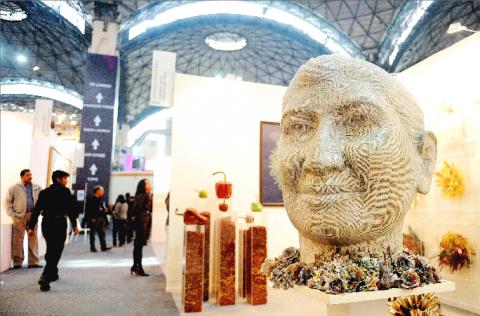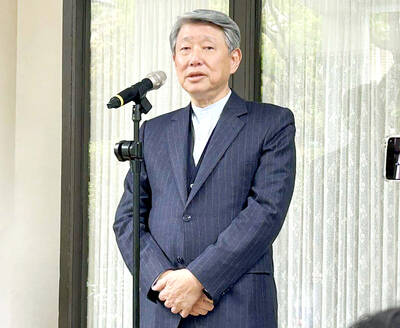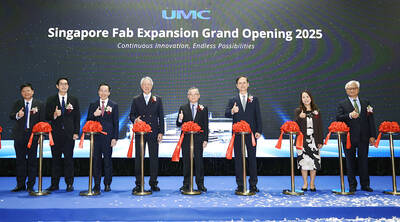India’s biggest art fair opened on Friday, pulling in dozens of foreign galleries seeking to tap a new breed of buyers in one of the world’s fastest-growing economies.
Now in its third edition, the annual Indian Art Summit has expanded sharply in both size and prominence, with 84 galleries taking part this year compared with 55 last time.
As well as offering rare global exposure for Indian artists, it also provides an exploratory platform for overseas dealers who feel India’s booming economy is minting a sizeable pool of wealthy buyers interested in international art.

Photo: AFP
The number of participating foreign galleries has doubled from last year to 34, with exhibitors from France, Germany, Canada, the US, Singapore and Japan.
“From the start, our objective was to create a window into the Indian art market,” the event’s director Neha Kirpal said. “We wanted to facilitate the growth of Indian art and its market within India, and to create a consolidated platform of Indian art for the world outside.”
The lack of both a vibrant museum culture and private funding for art events means public awareness, particularly of contemporary art, is still very much in its infancy in India.
However, overseas interest, following a general slump in prices in 2009, is regaining momentum — albeit with a strong focus on well-established artists.
Last year, a 1983 painting, Saurashtra, by Syed Haider Raza, sold for about £2.4 million (US$3.8 million) at Christie’s in London, setting a record for a modern Indian work.
“Serious collectors are there and this is backed with -confidence in the Indian -economy and with people investing as a hedge against inflation,” said Dinesh Vazirani, owner of online auctioneer Saffronart.
For many years, conventional wisdom had it that Indian collectors only bought Indian art, and the vast majority of the 500 artists whose works are being shown at the New Delhi event are either Indian or of Indian origin.
However, a number of foreign galleries, like the Frankfurt-based Die Galerie, believe there is an increasing desire among Indian buyers for foreign work.
“People here are eager, hungry and interested,” said the gallery’s owner Peter Femfert, whose booth boasted a number of pieces by the likes of Pablo Picasso, Joan Miro and Salvador Dali.
“You can’t just sit in your gallery and count dead flies in the window. You have to go out and find the customers,” said Femfert, a first time participant in the Delhi event.
“There are a few large Indian collectors of international art who have been buying abroad. It’s time for the sellers to come to India and offer something in this country,” he said.
While the works offered by Femfert carry the recognition value that might appeal to wealthy individuals looking for an investment — or the bragging rights that go with a Picasso in the living room — other gallery owners believe there is also a market in India for new, less established artists.
“It may still be early, but in the next five years I think we’re going to see a shift, with Indian buyers looking outside India,” said Paul Greenaway of the Greenaway Art Gallery in Australia.
“I’ll be really disappointed if all those second-string Picassos and Miros are the works that get sold. I hope there are discerning buyers here who will look beyond that stuff for some new, interesting works,” Greenaway said.
At the last Indian Art Summit in 2009, held during a cooling market, more than half the works on display were sold for a total of US$5.4 million — an impressive sum that fueled Kirpal’s ambitions for putting the event on a par with established contemporary art fairs.
It also impressed Genevieve Levesque of the Ottawa-based Arteria Gallery, a first-time participant who admitted she had no idea what sort of response to expect to the works of the young Canadian artists she had brought along.
“It’s a shot in the dark really, but a calculated one,” she said. “We feel there’s a slice of the cake available for everybody and that includes a rising demand for good, affordable art.”

MULTIFACETED: A task force has analyzed possible scenarios and created responses to assist domestic industries in dealing with US tariffs, the economics minister said The Executive Yuan is tomorrow to announce countermeasures to US President Donald Trump’s planned reciprocal tariffs, although the details of the plan would not be made public until Monday next week, Minister of Economic Affairs J.W. Kuo (郭智輝) said yesterday. The Cabinet established an economic and trade task force in November last year to deal with US trade and tariff related issues, Kuo told reporters outside the legislature in Taipei. The task force has been analyzing and evaluating all kinds of scenarios to identify suitable responses and determine how best to assist domestic industries in managing the effects of Trump’s tariffs, he

TIGHT-LIPPED: UMC said it had no merger plans at the moment, after Nikkei Asia reported that the firm and GlobalFoundries were considering restarting merger talks United Microelectronics Corp (UMC, 聯電), the world’s No. 4 contract chipmaker, yesterday launched a new US$5 billion 12-inch chip factory in Singapore as part of its latest effort to diversify its manufacturing footprint amid growing geopolitical risks. The new factory, adjacent to UMC’s existing Singapore fab in the Pasir Res Wafer Fab Park, is scheduled to enter volume production next year, utilizing mature 22-nanometer and 28-nanometer process technologies, UMC said in a statement. The company plans to invest US$5 billion during the first phase of the new fab, which would have an installed capacity of 30,000 12-inch wafers per month, it said. The

Taiwan’s official purchasing managers’ index (PMI) last month rose 0.2 percentage points to 54.2, in a second consecutive month of expansion, thanks to front-loading demand intended to avoid potential US tariff hikes, the Chung-Hua Institution for Economic Research (CIER, 中華經濟研究院) said yesterday. While short-term demand appeared robust, uncertainties rose due to US President Donald Trump’s unpredictable trade policy, CIER president Lien Hsien-ming (連賢明) told a news conference in Taipei. Taiwan’s economy this year would be characterized by high-level fluctuations and the volatility would be wilder than most expect, Lien said Demand for electronics, particularly semiconductors, continues to benefit from US technology giants’ effort

‘SWASTICAR’: Tesla CEO Elon Musk’s close association with Donald Trump has prompted opponents to brand him a ‘Nazi’ and resulted in a dramatic drop in sales Demonstrators descended on Tesla Inc dealerships across the US, and in Europe and Canada on Saturday to protest company chief Elon Musk, who has amassed extraordinary power as a top adviser to US President Donald Trump. Waving signs with messages such as “Musk is stealing our money” and “Reclaim our country,” the protests largely took place peacefully following fiery episodes of vandalism on Tesla vehicles, dealerships and other facilities in recent weeks that US officials have denounced as terrorism. Hundreds rallied on Saturday outside the Tesla dealership in Manhattan. Some blasted Musk, the world’s richest man, while others demanded the shuttering of his